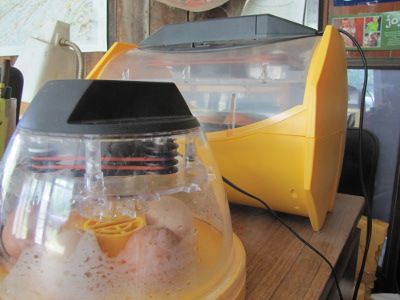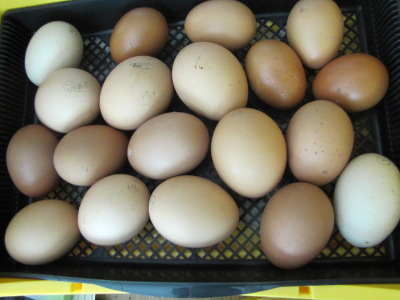
Space in the incubator during hatch
 I'm nervously gearing up for
hatch #2. The Brinsea
Octagon 20 Advance Incubator seems to have done its job perfectly,
never letting the interior temperature vary by more than 0.2 degrees
Fahrenheit, and I got the eggs
to lose just the right amount of weight. I'm expecting a very
high hatch rate...as long as I don't mess up these last two days.
I'm nervously gearing up for
hatch #2. The Brinsea
Octagon 20 Advance Incubator seems to have done its job perfectly,
never letting the interior temperature vary by more than 0.2 degrees
Fahrenheit, and I got the eggs
to lose just the right amount of weight. I'm expecting a very
high hatch rate...as long as I don't mess up these last two days.
Having unplugged the egg
turner and raised the humidity up for hatch, the only remaining problem
I foresee is the chicks killing each other. You may recall that
one of our chicks accidentally
speared another in the gut during the
last hatch, and I'm
concerned that the cramped conditions inside our current incubator
might create a repeat of that disaster. I moved five eggs to the Brinsea
Mini Advance incubator
Saturday afternoon so that I had space to lay all of the eggs down flat
in the bigger incubator, but even that could be a two-edged sword ---
the littler incubator might let the temperature vary more for the last
two days, but hopefully the mostly developed chicks can deal with a bit
of variation.

What I'm trying to
decide now is whether to move yet more eggs out of the big incubator
and into our faulty Little
Giant incubator once
they begin to pip. I'm far from confident about my ability to
control the temperature in there, but the extra space might be worth
sub-optimal temperature for the last day, and during my trial on
Saturday afternoon, temperatures stayed pretty steady in the styrofoam
incubator. Alternatively, I could wait until chicks hatch and
then carefully transfer them to the Little Giant for the dry-down
period, or I could just leave that incubator out of the mix
entirely. I'd love some advice from the hatchers among you.
Does more space trump better temperature control? Would you put
some eggs in the Little Giant or leave them all in the Brinsea
workhorse? (Am I crazy to think we might get 21 live chicks out
of our 24 eggs?)
Want more in-depth information? Browse through our books.
Or explore more posts by date or by subject.
About us: Anna Hess and Mark Hamilton spent over a decade living self-sufficiently in the mountains of Virginia before moving north to start over from scratch in the foothills of Ohio. They've experimented with permaculture, no-till gardening, trailersteading, home-based microbusinesses and much more, writing about their adventures in both blogs and books.
Want to be notified when new comments are posted on this page? Click on the RSS button after you add a comment to subscribe to the comment feed, or simply check the box beside "email replies to me" while writing your comment.

Thanks for chiming in! I'm willing to entertain any advice at this point.
Now that I think about it, the situation that caused the spearing in the last hatch could have been due to the weakness of the chick doing the spearing, which in turn was probably due to the temperature extremes during incubation. If the chick had been stronger, it probably could have gotten out of its egg faster and not had to crawl all over the neighbor in the process. Maybe I'll leave the eggs in the good incubators and just take the chicks out every few hours if they don't come all at once.
I'm wondering if you are going vaccinate your chicks?
We try doing things organicly but sometimes things dont work out well. The first group of chickens we raised were given food w/o additives to control coccidia. The 2nd batch received medicated feed as that was only feed available. The chicks on medicated feed grew to be much healthier than the first batch.